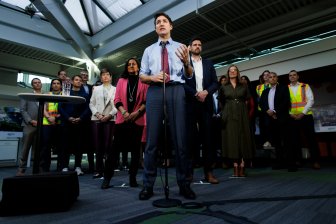In announcing the detail of his carbon tax, Prime Minister Justin Trudeau said “there is now a price on pollution” in Canada.

But there are some opponents to the carbon tax who are arguing the use of the word “pollution” when talking about carbon dioxide.
Maxime Bernier, a Quebec MP and leader of the newly-created People’s Party of Canada, took issue with the term in a Twitter thread on Wednesday.
“CO2 is NOT pollution. It’s what comes out of your mouth when you breathe and what nourishes plants,” he wrote.
“We can debate the effects of too much CO2 in the atmosphere on climate. That doesn’t make CO2 a form of ‘pollution,’” he argued.
But climate scientists disagree.
WATCH: Is the federal government carbon tax too punitive?

Myrna Simpson, a professor of environmental chemistry at the University of Toronto, said the fact that carbon dioxide levels in the atmosphere are “beyond natural levels,” and that these “increases in concentrations are fundamentally altering climate patterns” justifies calling CO2 a pollutant.
“Pollutants are everywhere in the environment but it is the concentration of the pollutant and not their presence that is more important,” she explained.
Talking points such as Bernier’s are “silly arguments” that “absolutely” detract from the fight against climate change, said Douw Steyn, professor in the department of Earth, Ocean and Atmospheric sciences at UBC.
“That’s a silly argument around minutiae and definitions to avoid the fact that carbon dioxide seriously disrupts the climate and therefore all ecosytems,” Steyn said.
“The point is everything we consider pollutants are natural background substances in the atmosphere, which become pollutants when their concentrations rise above the natural background concentration,” Steyn explained.
READ MORE: Confused about carbon taxes and rebates? Here’s what you need to know
The argument that carbon dioxide isn’t a pollutant has been used before — notably when former U.S. president George W. Bush’s administration refused to regulate carbon dioxide emissions in 2001.
At the time, Bush officials said “the Clean Air Act does not identify carbon dioxide as a pollutant.” The U.S. Supreme Court has since ruled that greenhouse gases like CO2 should be recognized and regulated as pollutants.
Excess carbon dioxide in the atmosphere is a “major driver of climate change,” Simpson simply stated.
A spokesperson for Bernier said while he “recognizes that CO2 can have an effect on climate change,” Bernier is just trying to highlight the fact that the Liberal government is calling a natural substance “toxic pollution.”
Instead of calling it a carbon tax, “they now call it a ‘pollution pricing system,’ even though its purpose is not to fight pollution but to fight climate change,” Bernier representative Martin Masse explained.
WATCH: Trudeau defends pricing pollution as a solution for climate change

The Prime Minister’s Office hasn’t responded to a request for comment by publication time.
In the government’s pollution pricing plan, large industrial facilities in certain provinces will be subject to a tax if they emit more than 50,000 tonnes of CO2 equivalent a year.
READ MORE: Confused about carbon taxes and rebates? Here’s what you need to know
Other ‘natural’ pollutants
Along with CO2, there are other natural substances that can be considered pollutants, including these examples.
Methane: Methane (CH4) can come from various sources, including from swamps, manure and flatulence from livestock. It’s also produced when burning fossil fuels. It’s increased in recent years (since 2006) due to an increase agriculture and an increase in fossil fuels, according to a team of scientists from NASA. Along with CO2, it contributes to the greenhouse effect.
Sulfur Dioxide: Produced naturally by erupting volcanoes, sulfur dioxide is also considered a pollutant. Since sulfur dioxide particles reflect light, it can keep sunlight out when there’s large amounts in the atmosphere, leading to small periods of cooling, Natural Geographic explains.




Comments